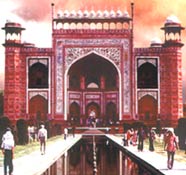|

|
Temples
Buddhist
Mughal
Forts
British
|

|
| |

In 1191, the first of many dynasties ruled by Islamic sultans captured Delhi and made it a power base for governing northern India. To celebrate the triumph of Islam, these sultans created an impressive complex of buildings outside Delhi, including a mosque with a very tall minaret (tower).
Hindu buildings reflected nature in both their shapes and decorations, but Islamic artists and architects were prohibited from using images, even though floral decoration was sometimes allowed. Instead they worked in pure geometric designs, reflecting the abstract definition of Allah.
The purity of the decoration on the Qutb Minar is a fine example of this art.
In the domain of architecture the Mughals made their remarkable contribution to Indian culture. The simplicity of the pre-Mughal architecture gave place to the delicate ornamental style of the Mughals. The Mughal architecture blended the Persian and Indian styles. Graceful domes, cupolas at the corners standing on pillars, a huge palace hall and vaulted gateway are some of the salient features of the Mughal architecture. The new style of building mausoleums in the middle of park-like enclosures and double domes was introduced by the
Mughals.
Buildings constructed during the reigns of Babur and Humayun, under the influence of Persian architecture were mostly unimpressed. Out of the structures built by Babur, only the mosque in Kabuli Bagh at Panipat and the Jama Masjid at Sambhal exist today. Sher Shah completed the the construction of Purana Qila at Delhi. The mosque in the Purana Qila known as Qila-i-Kuhana Masjid is admired by many today. Sher Shah's tomb which was built by himself at Sasaram in Bihar is one of the best architectural monuments in India. Mughal architecture had a new impetus in the reign of Akbar. The new style began by Sher Shah was developed by Akbar whose tolerant spirit and artistic sense made a synthesis of the Persian and Indian styles in architecture.
From the 1500's, the Mughal emperors continued to build, not only in Delhi but also in other capitals such as Agra and Lahore. In 1571, the emperor Akbar ordered the building of a completely new city called Fatehpur Sikri, near Agra. This city, an offering of thanksgiving by Akbar for the gift of sons who would carry on his line, was abandoned soon after it was built. It remains a perfect example of a Mughal city. It contains buildings constructed, like the Qutb Minar, of red sandstone. Because Akbar was anxious to promote cooperation between Muslims and Hindus, he allowed his Hindu stonemasons to embellish the buildings at Fatehpur Sikri with decorations that might have graced a Hindu palace.
Akbar ordered the building of several forts in defence of his major cities. His builders again used red sandstone for these stout buildings.
The red forts, like other buildings completed at the same time and made of the same material, have a heavy appearance. They take their colour from the Indian countryside and rise from the landscape like rocks and hills.
India's hot climate often influenced its architectural planning. The best-known building in Fatehpur Sikri is a five-storey pavilion with no walls. Only rows of pillars hold up the roof of one storey which becomes the floor of the one above. On the terraces of this pavilion, the emperor and his ladies could enjoy the views, shelter from the sun, and take advantage of cooling breezes.
Garden design also owed much to the Indian climate. The emperor and his court spent much of the year in Kashmir, where people lived outdoors.
The gardens of the emperor and his nobles had terraces and stairways with streams running alongside them carrying cool water down from the mountains to nearby lakes. There was also a complex system of fountains and cascades. At Delhi and Agra, special channels carried cooling water through the interiors of buildings.
In the 1600's, Akbar's grandson, the emperor Shah Jahan, built mosques and other buildings within the Red Forts of Delhi and Agra. These buildings were made of glistening white marble. So too was the magnificent Taj Mahal, the tomb that Shah Jahan ordered for his wife beside the
J amuna
River, at Agra.
|




